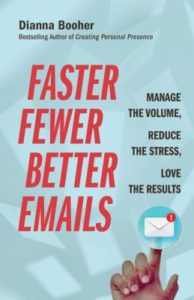


(This column first appeared on CEOWorld.Biz)
For more than three decades, I’ve been reading other people’s mail. That is, corporate emails to and from people at all levels in client organizations across myriad industries—hundreds of thousands of emails. My firm analyzes why the original versions don’t work, why the edited versions get better responses, and ultimately how to make communication more productive and effective throughout the organization.
The most revealing thing in our work? “Impact” stories. The lawsuits based on sloppy wording. The loss of clients and contracts because of insensitive remarks. Inaccurate payments caused by missing information. Frustration, missed deadlines, lost productivity because of inconsistency in filing important documents.
This entire article could be a collection of such blunders and their associated career and organizational costs. But that would only cause more stress. Instead, my aim is to make email work FOR you. The goal is to fix these problems!
Unfortunately, whether at work or on vacation, most of us are still tapping away. At the airport. At the soccer field or gym. At the beach. From a hospital bed—yours or that of a loved one. At bedtime. At sunrise. Over lunch. Chances are, your email habits drain you, both mentally and emotionally. That spells lost productivity for your organization and stress for you. We were told more than two decades ago that email would revolutionize the way we work and save us an enormous amount of time. While email has many benefits, it has also engulfed us and created other productivity drains.
My organization, Booher Research Institute, recently commissioned a survey of email communication habits and productivity from the Social Research Lab at the University of Northern Colorado. Here’s what a representative sampling of knowledge workers across multiple industries reported about their email habits:
–42 percent spend 3 hours or more per day reading and writing email (The average employee spends 2 to 2.5 hours per day.)
–55 percent check email either hourly or multiple times per hour
–34 percent say the email they get is redundant or irrelevant to their needs
–31 percent spend more than 20 minutes a day searching for lost documents
–28 percent have been scammed by email
While some experts predicted back in the 1990s that communication technology could potentially improve our productivity by 20–25 percent, a McKinsey Global Institute study found that, in actuality, technology reduces our productivity by 28 percent for any number of reasons—interruptions, distractions, disorganization, and not finding information to reply with.[i]
To calculate the cost to an organization, consider a $75,000 salary as an illustration.
1. Multiply the base salary by 1.4 to account for benefits.
$75,000 (annual salary of employee)
´ 1.4 (salary plus benefits)
$105,000 (total annual cost of employee, salary & benefits)
2. Multiply total employee cost by percent of time spent on email. (2.5 hours/day X 5 days/week = 12.5 hours of a 40-hour week. Roughly 30 percent of the average worker’s time is spent on email.)
$105,000 (annual employee cost)
´ .30 (percent of time spent on email)
$31,500 (total cost to do email 2.5 hours/day—one employee)
$315,000 (total cost to do email 2.5 hours/day—if 10 employees)
$3,150,000 (total cost to do email 2.5 hours/day—if 100 employees)
To figure out how much of your own salary you “spend” on email, plug your salary into the above formula. It’s easy to see the payoff for learning to tame the email monster and reclaim uninterrupted work time.
Here’s a starter set of strategies:
Decide what’s counterproductive or harmful to your brand. For example, limit email distribution lists to the real “need to know.” Stop using email for tasks better handled by other software programs like calendaring programs and project management software. Back in the 1990s when email software was the only game in town, we emailed about everything. Now we have specific software for more focused tasks.
Help writers learn to summarize their message in the first sentence. Then their email should state any recommended action or follow-up action clearly. Far too many professionals write “So what?” emails. After recipients read incoming emails, their response is “So what?” Unclear action leads to another 3 or 4 email exchanges—and more wasted time.
Make employees aware of the importance of changing passwords frequently, storing passwords securely, avoiding sensitive issues in writing, and following copyright regulations in passing on documents or files they don’t own.
Today, most substantive correspondence takes place through email. In essence, how your employees handle email determines productivity and communication flow throughout the organization. Adopt smart habits to cut costs and improve your core work.
Learn more ways to manage your email with Dianna’s new book Faster, Fewer, Better Emails: Manage the Volume, Reduce the Stress, Love the Results. Click here for more information.
